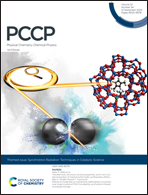A theoretical strategy for pressure-driven ferroelectric transition associated with critical behavior and magnetoelectric coupling in organic multiferroics
Abstract
In organic multiferroics, the charge or spin coupled to the lattice induces lattice symmetry breaking, which is responsible for the ferroelectric (FE) transition. We propose a quantum spin model to describe the ferroelectricity of organic multiferroics, in which the pressure-driven spin–lattice coupling is controlled both by a jump function and a pressure power function. The T–p phase diagram shows different scaling relationships at low and high pressure regions, respectively, which is in accordance with the experimental observation. It is found that the pressure can not only enhance the FE polarization, but also enhance the transition temperature Tc as well as the electrocaloric effect (ECE). The electrocaloric critical scaling laws are proposed to verify the order and universality of the FE transition based on the Banerjee and Franco's criteria. In addition, we propose a temperature mediated mechanism within an isentropic process based on the ECE combined with the pyromagnetic effect, together with multiple physically (magnetic field and pressure jointly) controlled means, to enhance the magnetoelectric coupling around room-temperature, which will provide thermodynamic and quantum controlled means for realizing multi-state logic memory.



 Please wait while we load your content...
Please wait while we load your content...